Troy-Bilt 30245 User Manual
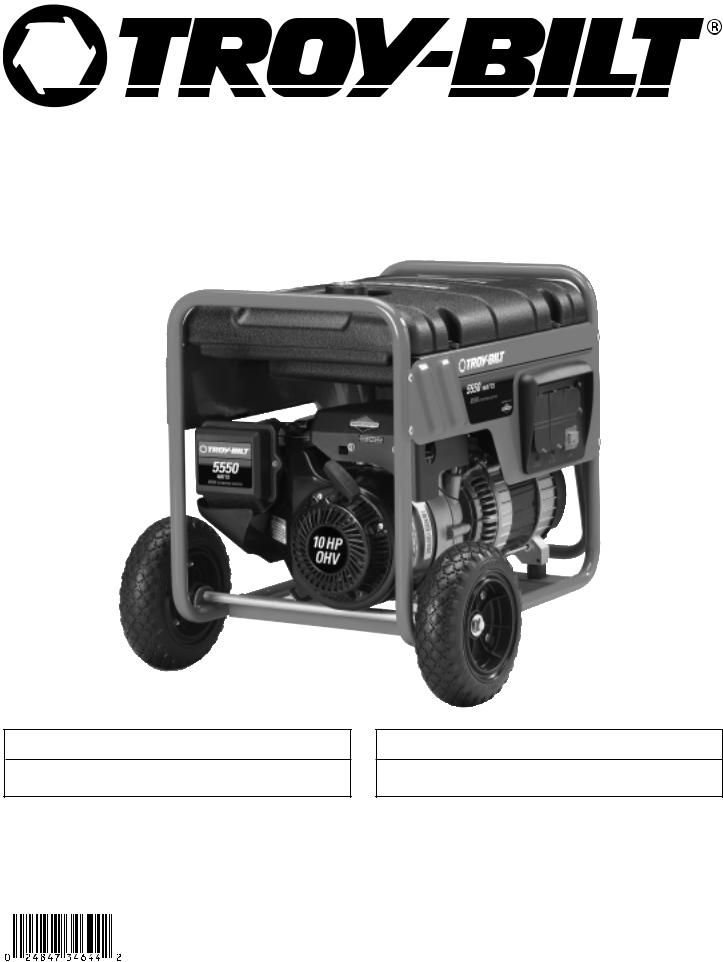
Operator’s Manual / Manual del Operario
Portable Generator / Generador Portátil
Model / Modelo 030245
 WARNING
WARNING
Before using this product, read this manual and follow all Safety Rules and Operating Instructions.
 ADVERTENCIA
ADVERTENCIA
Antes de utilizar el producto, lea este manual y siga todas las Reglas de Seguridad e Instrucciones de Uso.
Questions? Preguntas?
Helpline - 1-888-611-6708 M-F 8-5 CT
Troy-Bilt® is a registered trademark of Troy-Bilt, LLC and is used under license to Briggs & Stratton Power Products. Troy-Bilt® es una marca registrada de Troy-Bilt, LLC y se usa abajo licencia a Briggs & Stratton Power Products.
BRIGGS & STRATTON POWER PRODUCTS GROUP, LLC
JEFFERSON,WISCONSIN, U.S.A.
Printed in USA |
Manual No. 198375GS Revision B (06/21/2006) |

Section |
Safety Rules |
|
1
SAVE THESE INSTRUCTIONS
TABLE OF CONTENTS
Section 1 - Safety Rules . . . . . . . . . . . . . . . . . . . . . . . . . . 2-4
Section 2 - Features and Controls . . . . . . . . . . . . . . . . . . . 5
Section 3 - Assembly . . . . . . . . . . . . . . . . . . . . . . . . . . . . 6-7
Section 4 - Operation . . . . . . . . . . . . . . . . . . . . . . . . . . 8-11
Section 5 - Maintenance . . . . . . . . . . . . . . . . . . . . . . . . . . 12
Section 6 - Storage . . . . . . . . . . . . . . . . . . . . . . . . . . . . . . 13
Section 7 - Troubleshooting. . . . . . . . . . . . . . . . . . . . . . . . 14
Warranty . . . . . . . . . . . . . . . . . . . . . . . . . . . . . . . . . . . . . . 15
EQUIPMENT
DESCRIPTION
Read this manual carefully and become familiar with your generator. Know its applications, its limitations and any hazards involved.
The generator is an engine–driven, revolving field, alternating current (AC) generator. It was designed to supply electrical power for operating compatible electrical lighting, appliances, tools and motor loads.The generator’s revolving field is driven at about 3,600 rpm by a singlecylinder engine.
SAFETY RULES
This is the safety alert symbol. It is used to alert you to potential personal injury hazards. Obey all safety messages that follow this symbol to avoid possible injury or death.
The safety alert symbol ( ) is used with a signal word (DANGER, CAUTION,WARNING), a pictorial and/or a safety message to alert you to hazards. DANGER indicates a hazard which, if not avoided, will result in death or serious injury. WARNING indicates a hazard which, if not avoided, could result in death or serious injury. CAUTION indicates a hazard which, if not avoided, might result in minor or moderate injury. CAUTION, when used without the alert symbol, indicates a situation that could result in equipment damage. Follow safety messages to avoid or reduce the risk of injury or death.
) is used with a signal word (DANGER, CAUTION,WARNING), a pictorial and/or a safety message to alert you to hazards. DANGER indicates a hazard which, if not avoided, will result in death or serious injury. WARNING indicates a hazard which, if not avoided, could result in death or serious injury. CAUTION indicates a hazard which, if not avoided, might result in minor or moderate injury. CAUTION, when used without the alert symbol, indicates a situation that could result in equipment damage. Follow safety messages to avoid or reduce the risk of injury or death.
 WARNING
WARNING
The engine exhaust from this product contains chemicals known to the State of California to cause cancer, birth defects, or other reproductive harm.
CAUTION! DO NOT exceed the generator’s wattage/amperage capacity. See “Don’t Overload Generator”.
Every effort has been made to ensure that information in this manual is accurate and current. However, we reserve the right to change, alter or otherwise improve the product and this document at any time without prior notice.
The Emission Control System for this generator is warranted for standards set by the Environmental Protection Agency and the California Air Resources Board. For warranty information refer to the Engine Operator’s Manual.
Hazard Symbols and Meanings
Operator’s Manual |
Electrical Shock |
||
Explosion |
Fire |
|
Flying Objects |
Toxic Fumes |
Kickback |
Hot Surface |
|
Copyright © 2006 Briggs & Stratton Power Products Group, LLC. All rights reserved. No part of this material may be reproduced or transmitted in any form by any means without the express written permission of Briggs & Stratton Power Products Group, LLC.
2
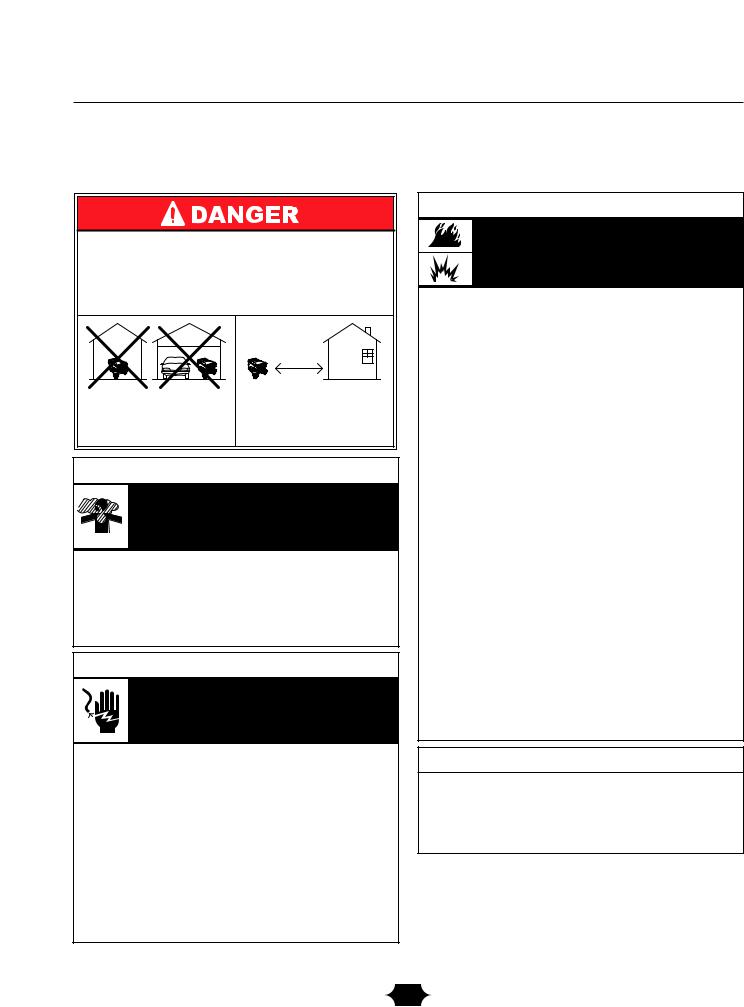
Section 1: Safety Rules
Using a generator indoors WILL KILL YOU IN MINUTES.
Exhaust contains carbon monoxide, a poison gas you cannot see or smell.
NEVER use in the home ONLY use outdoors and or in partly enclosed far from open windows, areas such as garages. doors, and vents.
 WARNING
WARNING
Running generator gives off carbon monoxide, an odorless, colorless, poison gas.
Breathing carbon monoxide can cause nausea, fainting or death.
•Operate generator ONLY outdoors.
•Keep exhaust gas from entering a confined area through windows, doors, ventilation intakes or other openings.
•DO NOT operate generator inside any building or enclosure (even if doors or windows are open), including the generator compartment of a recreational vehicle (RV).
WARNING
Generator produces powerful voltage.
Failure to isolate generator from power utility can result in death or injury to electric utility workers due to backfeed of electrical energy.
•When using generator for backup power, notify utility company. Use approved transfer equipment to isolate generator from electric utility.
•Use a ground fault circuit interrupter (GFCI) in any damp or
highly conductive area, such as metal decking or steel work.
•DO NOT touch bare wires or receptacles.
•DO NOT use generator with electrical cords which are worn, frayed, bare or otherwise damaged.
•DO NOT operate generator in the rain or wet weather.
•DO NOT handle generator or electrical cords while standing
in water, while barefoot, or while hands or feet are wet.
•DO NOT allow unqualified persons or children to operate or service generator.
 WARNING
WARNING
Fuel and its vapors are extremely flammable and explosive.
Fire or explosion can cause severe burns or death.
WHEN ADDING OR DRAINING FUEL
•Turn generator OFF and let it cool at least 2 minutes before removing fuel cap. Loosen cap slowly to relieve pressure in tank.
•Fill or drain fuel tank outdoors.
•DO NOT overfill tank.Allow space for fuel expansion.
• If fuel spills, wait until it evaporates before starting engine.
•Keep fuel away from sparks, open flames, pilot lights, heat, and other ignition sources.
•DO NOT light a cigarette or smoke.
WHEN STARTING EQUIPMENT
• Ensure spark plug, muffler, fuel cap and air cleaner are in place.
• DO NOT crank engine with spark plug removed.
WHEN OPERATING EQUIPMENT
•Do not tip engine or equipment at angle which causes fuel to spill.
•This generator is not for use in mobile equipment or marine applications.
WHEN TRANSPORTING OR REPAIRING EQUIPMENT
•Transport/repair with fuel tank EMPTY or with fuel shutoff valve OFF.
•Disconnect spark plug wire.
WHEN STORING FUEL OR EQUIPMENT WITH FUEL IN TANK
•Store away from furnaces, stoves, water heaters, clothes dryers or other appliances that have pilot light or other ignition source because they can ignite fuel vapors.
 WARNING
WARNING
•This generator does not meet U. S. Coast Guard Regulation 33CFR-183 and should not be used on marine applications.
•Failure to use the appropriate U. S. Coast Guard approved generator could result in death or serious injury and/or property damage.
3
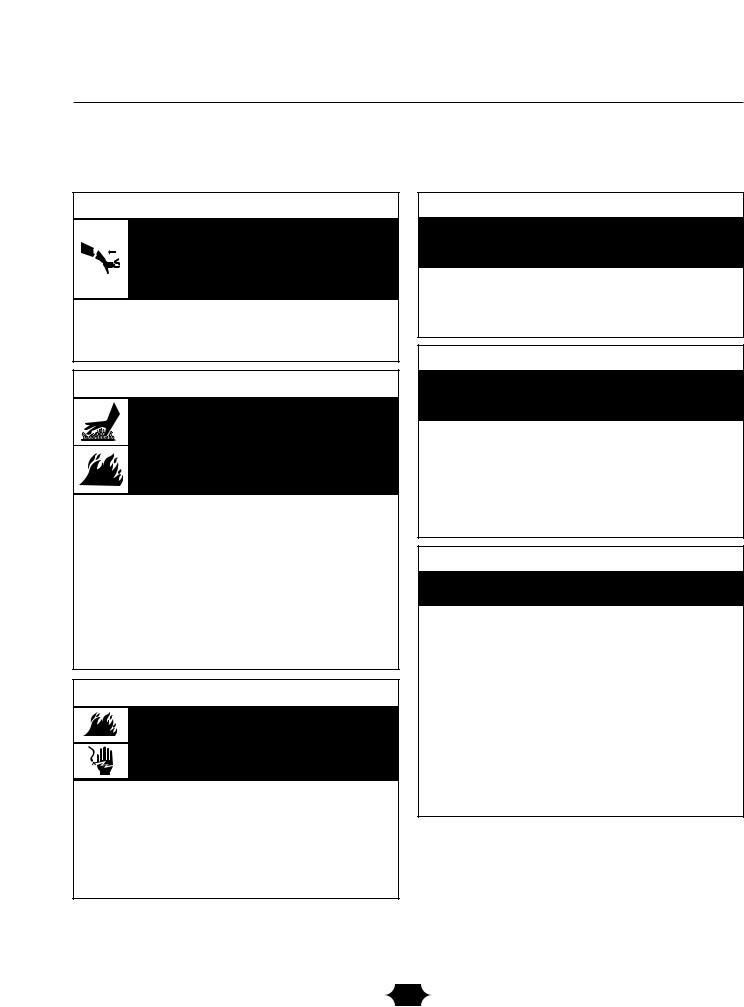
Section 1: Safety Rules
 WARNING
WARNING
Rapid retraction of starter cord (kickback) will pull hand and arm toward engine faster than you can let go.
Broken bones, fractures, bruises or sprains could result.
•When starting engine, pull cord slowly until resistance is felt and then pull rapidly to avoid kickback.
•NEVER start or stop engine with electrical devices plugged in and turned on.
 WARNING
WARNING
Running engines produce heat.Temperature of muffler and nearby areas can reach or exceed 150°F (65°C).
Severe burns can occur on contact.
Exhaust heat/gases can ignite combustibles, structures or damage fuel tank causing a fire.
•DO NOT touch hot surfaces and avoid hot exhaust gases.
•Allow equipment to cool before touching.
•Keep at least 5 ft. (152 cm) clearance on all sides of generator including overhead.
•Code of Federal Regulation (CFR) Title 36 Parks, Forests, and Public Property require equipment powered by an internal combustion engine to have a spark arrester, maintained in effective working order, complying to USDA Forest service standard 5100-1C or later revision. In the State of California a spark arrester is required under section 4442 of the California Public resources code. Other states may have similar laws.
 WARNING
WARNING
Unintentional sparking can result in fire or electric shock.
WHEN ADJUSTING OR MAKING REPAIRS TO YOUR GENERATOR
•Disconnect the spark plug wire from the spark plug and place the wire where it cannot contact spark plug.
WHEN TESTING FOR ENGINE SPARK
•Use approved spark plug tester.
•DO NOT check for spark with spark plug removed.
 CAUTION
CAUTION
Excessively high operating speeds increase risk of injury and damage to generator.
Excessively low speeds impose a heavy load.
•DO NOT tamper with governed speed. Generator supplies correct rated frequency and voltage when running at governed speed.
•DO NOT modify generator in any way.
CAUTION
Exceeding generators wattage/amperage capacity can damage generator and/or electrical devices connected to it.
•See “Don’t Overload Generator”.
•Start generator and let engine stabilize before connecting electrical loads.
•Connect electrical loads in OFF position, then turn ON for operation.
•Turn electrical loads OFF and disconnect from generator before stopping generator.
CAUTION
Improper treatment of generator can damage it and shorten its life.
•Use generator only for intended uses.
•If you have questions about intended use, ask dealer or call 1-888-611-6708.
•Operate generator only on level surfaces.
•DO NOT expose generator to excessive moisture, dust, dirt, or corrosive vapors.
•DO NOT insert any objects through cooling slots.
•If connected devices overheat, turn them off and disconnect them from generator.
•Shut off generator if:
-electrical output is lost;
-equipment sparks, smokes, or emits flames; -unit vibrates excessively.
4
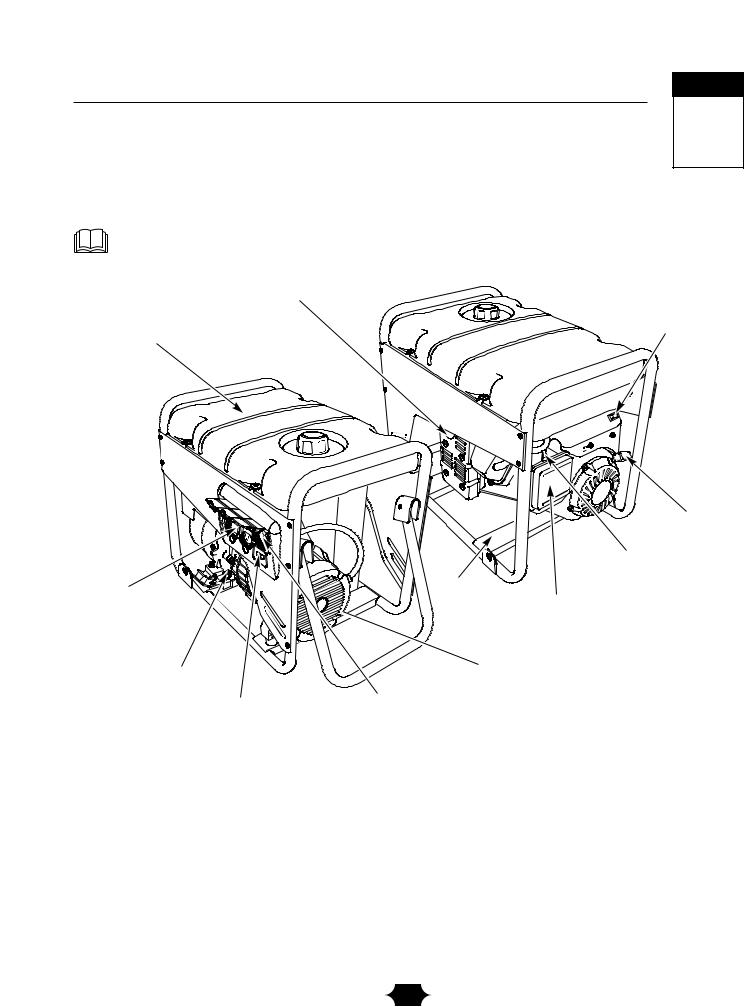
Features and Controls Section
2
KNOW YOUR GENERATOR
Read this Operator’s Manual and safety rules before operating your generator.
Compare the illustrations with your generator, to familiarize yourself with the locations of various controls and adjustments. Save this manual for future reference.
Spark Arrester Muffler
Rocker Switch
Fuel Tank
Recoil Starter
Choke Lever
120 Volt AC, 20 Amp |
Data Tag |
|
Air Cleaner |
||
Duplex Receptacles |
||
|
||
Oil Fill |
Grounding Fastener |
|
Double Pole Circuit |
120/240 Volt AC, |
|
Breaker (AC) |
30 Amp Receptacle |
120 Volt AC, 20 Amp, Duplex Receptacles — May be used to supply electrical power for the operation of
120 Volt AC, 20 Amp, single phase, 60 Hz electrical, lighting, appliance, tool and motor loads.
120/240 Volt AC, 30 Amp Locking Receptacle — May be used to supply electrical power for the operation of 120 and/or 240 Volt AC, 30 Amp, single phase, 60 Hz electrical, lighting, appliance, tool and motor loads.
Air Cleaner — Protects engine by filtering dust and debris out of intake air.
Choke Lever — Used when starting a cold engine.
Data Tag — Provides model, revision and serial number of generator. Please have these readily available when calling for assistance.
Double Pole Circuit Breaker (AC) — A double pole circuit breaker is provided to protect all the receptacles and generator against electrical overload.
Fuel Tank — Capacity of five (5) U.S. gallons.
Grounding Fastener — Consult your local agency having jurisdiction for grounding requirements in your area.
Oil Fill — Add engine oil here.
Recoil Starter — Used to start the engine.
Rocker Switch — Set this switch to "On" before using recoil starter. Set switch to "Off" to switch off engine.
Spark Arrester Muffler — Exhaust muffler lowers engine noise and is equipped with a spark arrester screen.
5
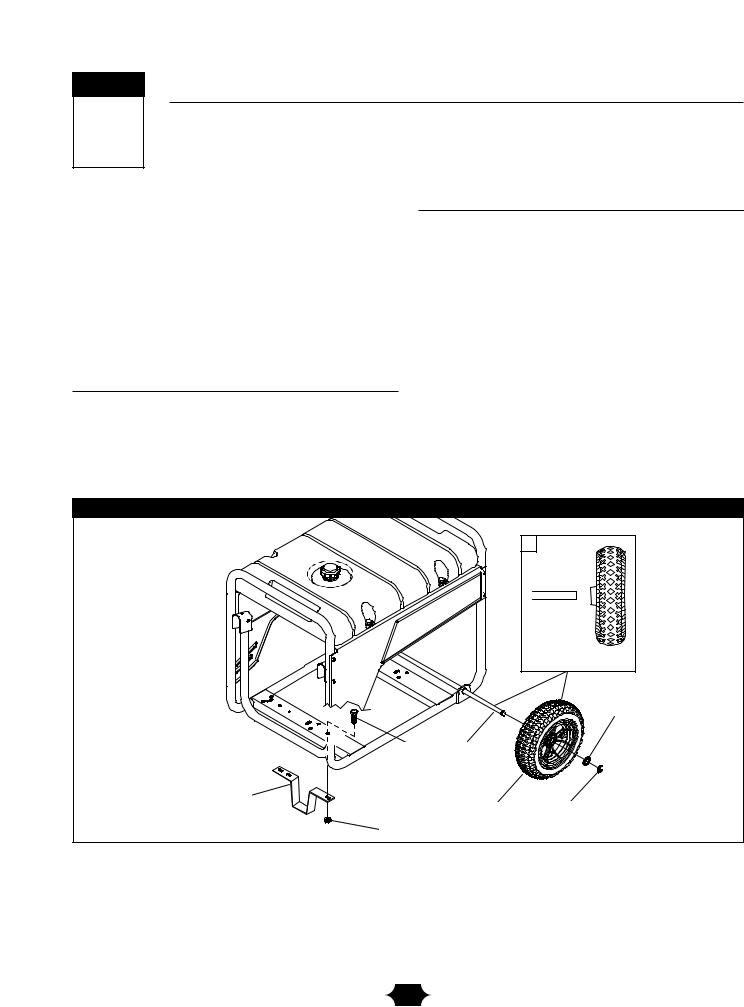
Section Assembly
3
ASSEMBLY
Your generator requires some assembly and is ready for use after it has been properly serviced with the recommended oil and fuel.
If you have any problems with the assembly of your generator, please call the generator helpline at 1-888-611-6708. If calling for assistance, please have the model, revision, and serial number from the data tag available. See “Know Your Generator” for data tag location.
Unpack the Generator
1.Set the carton on a rigid flat surface.
2.Remove everything from carton except generator.
3.Open carton completely by cutting each corner from top to bottom.
4.Leave generator on carton to install wheel kit.
Figure 1 — Install Wheel Kit
Install Wheel Kit
NOTE: Wheel kit is not intended for over-the-road use. You will need the following tools to install these components:
•13mm wrench
•Socket wrench with a 13mm socket
•Pliers
•Safety glasses
Refer to Figure 1 and install the wheel kit as follows:
1.Tip generator so that engine end is up.
2.Slide axle through both mounting brackets.
3.Place a wheel on each side as shown in Figure 1A.
4.Place a washer on axle and then place an e-ring in axle groove.
A |
Axle |
Wheel |
Flat Washer
Capscrew Axle
Support Leg
Wheel E-Ring
Hex Nut
6
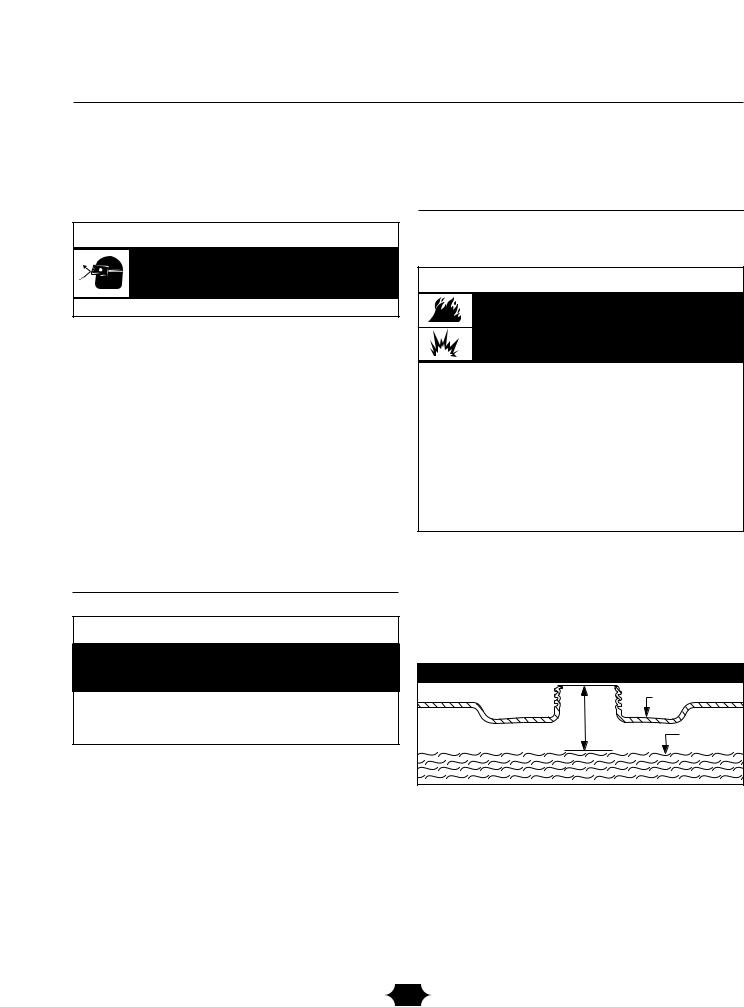
Section 3: Assembly
5.Install e-ring with pliers, squeezing from top of e-ring to bottom of axle.
 CAUTION
CAUTION
E-rings can cause eye injury.
E-rings can spring back and become airborne when installing or removing.
• Always wear eye protection when installing/removing e-rings.
6.Repeat step 4 and 5 to secure second wheel.
7.Tip generator so that engine side is down.
8.Line up holes in support leg with holes in generator frame.
9.Attach support leg using 2 capscrews (M8 x 16 mm) and 2 hex nuts.Tighten with a 13mm socket wrench and 13mm wrench.
10.Return generator to normal operating position (resting on wheels and support leg).
BEFORE STARTING THE ENGINE
Add Engine Oil
• Place generator on a level surface.
CAUTION
Any attempt to crank or start the engine before it has been properly filled with the recommended oil will result in equipment failure.
•Refer to engine operator’s manual for oil fill information.
•Damage to equipment resulting from failure to follow this instruction will void warranty.
•Refer to engine operator’s manual and follow oil recommendations and instructions.
NOTE: Check oil often during engine break–in. Refer to engine operator’s manual for recommendations.
NOTE: The alternator assembly rotates on a prelubricated and sealed ball bearing that requires no additional lubrication for the life of the bearing.
Add Fuel
NOTE: This gasoline engine is certified to operate on gasoline. Exhaust Emission Control System: EM (Engine Modifications).
 WARNING
WARNING
Fuel and its vapors are extremely flammable and explosive.
Fire or explosion can cause severe burns or death.
WHEN ADDING FUEL
•Turn generator OFF and let it cool at least 2 minutes before removing fuel cap. Loosen cap slowly to relieve pressure in tank.
•Fill fuel tank outdoors.
•DO NOT overfill tank.Allow space for fuel expansion.
•Wait for spilled fuel to evaporate before starting engine.
•Keep fuel away from sparks, open flames, pilot lights, heat, and other ignition sources.
•DO NOT light a cigarette or smoke.
1.Use clean, fresh, regular UNLEADED gasoline with a minimum of 87 octane. DO NOT use fuel which contains Methanol. DO NOT mix oil with fuel.
2.Clean area around fuel fill cap, remove cap.
3.Slowly add regular unleaded gasoline to fuel tank. Be careful not to overfill. Allow at least 1.5" of tank space for fuel expansion (Figure 2).
Figure 2 - Fuel Expansion
AirSpace |
Tank |
|
Fuel |
||
1.5” |
||
|
4.Install fuel cap and let any spilled fuel evaporate before starting engine.
7
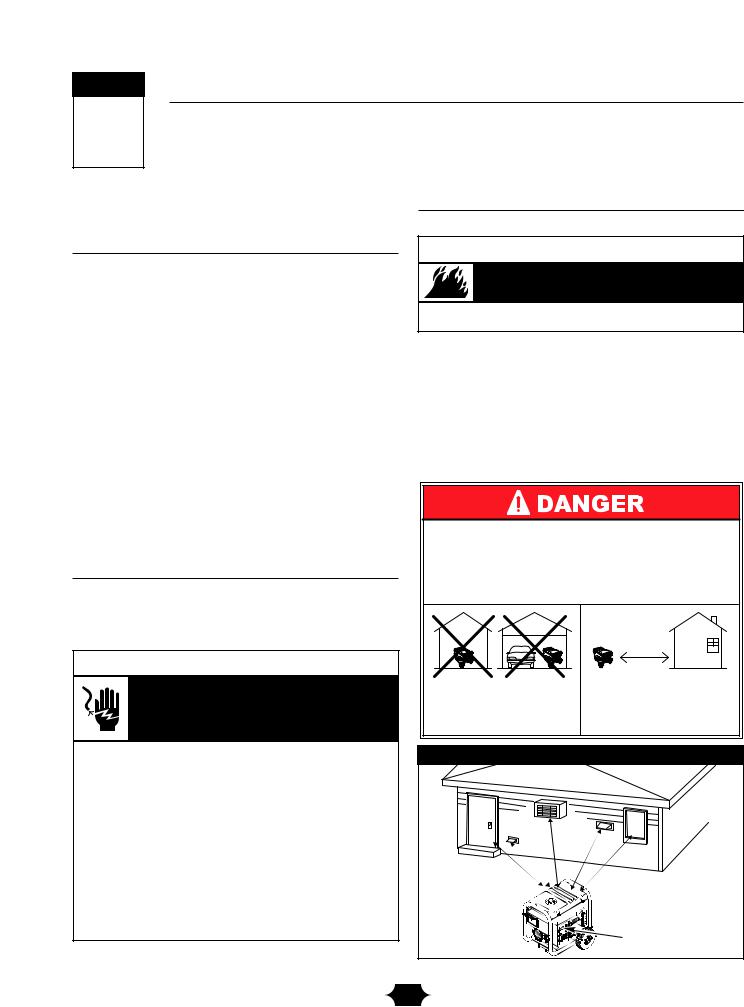
Section Operation
4
USING THE GENERATOR
System Ground
The generator has a system ground that connects the generator frame components to the ground terminals on the AC output receptacles.The system ground is connected to the AC neutral wire (the neutral is bonded to the generator frame).
Special Requirements
There may be Federal or State Occupational Safety and Health Administration (OSHA) regulations, local codes, or ordinances that apply to the intended use of the generator. Please consult a qualified electrician, electrical inspector, or the local agency having jurisdiction.
•In some areas, generators are required to be registered with local utility companies.
•The generator's receptacles and the provided adapter cord set are not protected by a Ground Fault Circuit Interrupter (GFCI). If used on an OSHA governed job site, appropriate GFCI protection must be utilized.
Connecting to a Building’s Electrical System
Connections for standby power to a building’s electrical system must be made by a qualified electrician.The connection must isolate the generator power from utility power, and must comply with all applicable laws and electrical codes.
 WARNING
WARNING
Generator produces powerful voltage.
Failure to isolate generator from power utility can result in death or injury to electric utility workers due to backfeed of electrical energy.
•When using generator for backup power, notify utility company. Use approved transfer equipment to isolate generator from electric utility.
•Use a ground fault circuit interrupter (GFCI) in any damp or highly conductive area, such as metal decking or steel work.
•DO NOT touch bare wires or receptacles.
•DO NOT use generator with electrical cords which are worn, frayed, bare or otherwise damaged.
•DO NOT operate generator in the rain or wet weather.
•DO NOT handle generator or electrical cords while standing
in water, while barefoot, or while hands or feet are wet.
•DO NOT allow unqualified persons or children to operate or service generator.
Generator Location
Generator Clearance
 WARNING
WARNING
Exhaust heat/gases can ignite combustibles, structures or damage fuel tank causing a fire.
•Keep at least 5 ft. (152 cm) clearance on all sides of generator including overhead.
Place generator in a well ventilated area, which will allow for removal of deadly exhaust gas. DO NOT place generator where exhaust gas could accumulate and enter inside or be drawn into a potentially occupied building. Ensure exhaust gas is kept away from any windows, doors, ventilation intakes or other openings that can allow exhaust gas to collect in a confined area (Figure 3). Prevailing winds and air currents should be taken into consideration when positioning generator.
Using a generator indoors WILL KILL YOU IN MINUTES.
Exhaust contains carbon monoxide, a poison gas you cannot see or smell.
NEVER use in the home ONLY use outdoors and or in partly enclosed far from open windows, areas such as garages. doors, and vents.
Figure 3 — Generator Clearance
Typical Generator Shown
Exhaust Port |
8
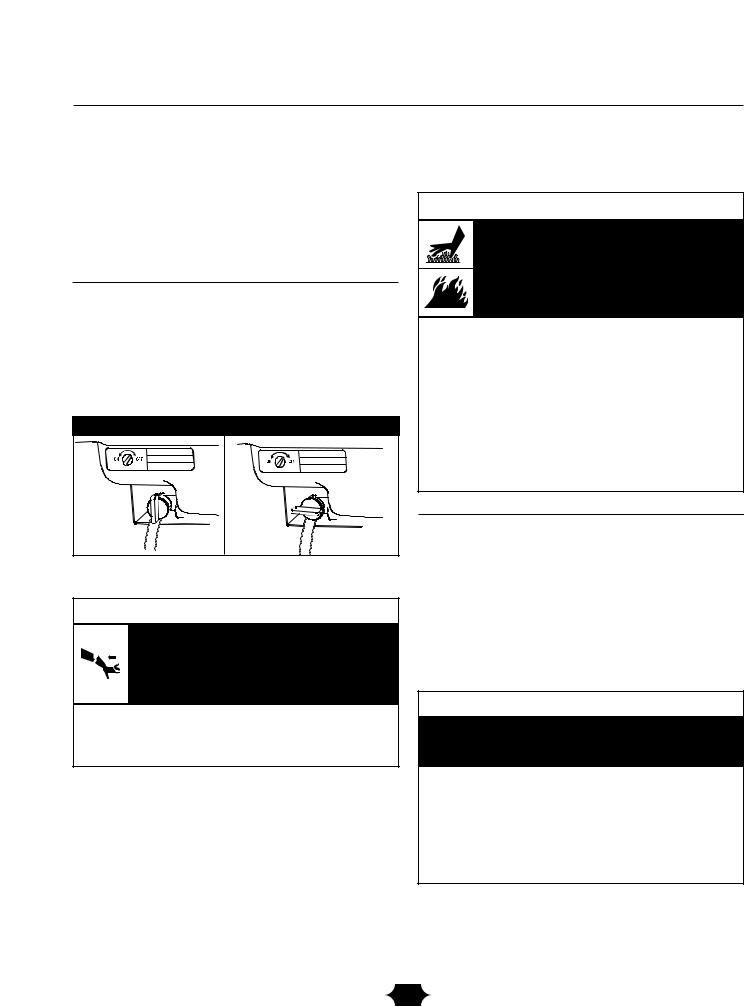
Section 4: Operation
OPERATING THE
GENERATOR
Starting the Engine
Disconnect all electrical loads from the generator. Use the following start instructions:
1.Make sure unit is on a level surface.
IMPORTANT: Failure to start and operate unit on a level surface will cause the unit not to start or shut down during operation.
2.Turn red fuel valve to “On” position (Figure 4).
Figure 4 — Fuel Valve
“Off” |
“On” |
Position |
Position |
3.Start engine according to instructions given in engine operator’s manual.
 WARNING
WARNING
Rapid retraction of starter cord (kickback) will pull hand and arm toward engine faster than you can let go.
Broken bones, fractures, bruises or sprains could result.
•When starting engine, pull cord slowly until resistance is felt and then pull rapidly to avoid kickback.
•NEVER start or stop engine with electrical devices plugged in and turned on.
NOTE: If engine starts after 3 pulls but fails to run, or if unit shuts down during operation, make sure unit is on a level surface and check for proper oil level in crankcase.
This unit may be equipped with a low oil protection device. See engine operator’s manual.
 WARNING
WARNING
Running engines produce heat.Temperature of muffler and nearby areas can reach or exceed 150°F (65°C).
Severe burns can occur on contact.
Exhaust heat/gases can ignite combustibles, structures or damage fuel tank causing a fire.
•DO NOT touch hot surfaces and avoid hot exhaust gases.
•Allow equipment to cool before touching.
•Keep at least 5 ft. (152 cm) clearance on all sides of generator including overhead.
•Code of Federal Regulation (CFR) Title 36 Parks, Forests, and Public Property require equipment powered by an internal combustion engine to have a spark arrester, maintained in effective working order, complying to USDA Forest service standard 5100-1C or later revision. In the State of California a spark arrester is required under section 4442 of the California Public resources code. Other states may have similar laws.
Connecting Electrical Loads
•Let engine stabilize and warm up for a few minutes after starting.
•Plug in and turn on the desired 120 and/or 240 Volt AC, single phase, 60 Hz electrical loads.
•DO NOT connect 240 Volt loads to the 120 Volt duplex receptacles.
•DO NOT connect 3–phase loads to the generator.
•DO NOT connect 50 Hz loads to the generator.
•DO NOT OVERLOAD THE GENERATOR. See “Don’t Overload Generator”.
CAUTION
Exceeding generator’s wattage/amperage capacity can damage generator and/or electrical devices connected to it.
•See “Don’t Overload Generator”.
•Start generator and let engine stabilize before connecting electrical loads.
•Connect electrical loads in OFF position, then turn ON for operation.
•Turn electrical loads OFF and disconnect from generator before stopping generator.
9
